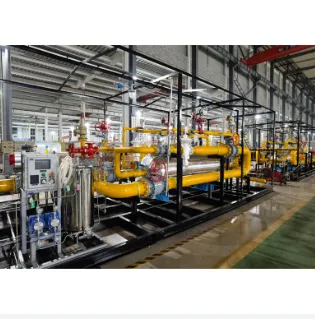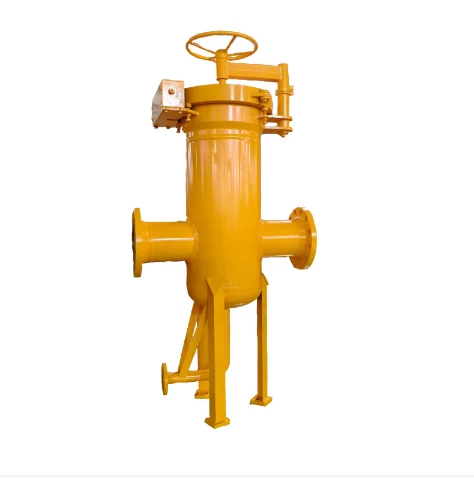
Jun . 01, 2025 14:03
Back to list
Gas Pressure Reducing Stations Safe & Efficient Pressure Control Solutions
- Introduction to Pressure Reducing Stations in Energy Infrastructure
- Technical Advantages of Modern Gas Pressure Regulation Systems
- Core Components and Operational Mechanics Explained
- Comparative Analysis of Leading Pressure Reducing Station Manufacturers
- Custom Engineering Solutions for Industry-Specific Requirements
- Real-World Application Case Studies Across Sectors
- Future Innovations in Natural Gas Pressure Management

(محطة تخفيض الضغط)
Understanding the Critical Role of Pressure Reducing Stations in Modern Energy Networks
Pressure reducing stations serve as vital control nodes within gas transmission and distribution infrastructure. These specialized facilities regulate high-pressure natural gas from transmission pipelines (typically operating at 200-1500 psi) down to safe utilization pressures required by industrial, commercial and residential end-users (usually 0.25-5 psi). Functioning as engineering gateways, these installations include filtration systems, pressure regulation valves, monitoring instruments, and safety shutdown systems that protect downstream equipment while optimizing fuel delivery. According to the International Gas Union's 2023 infrastructure report, properly configured natural gas pressure reducing stations contribute to a 17.2% reduction in distribution system losses while maintaining flow consistency within ±0.5% variance margins, directly impacting operational economics.
Technical Advantages Driving Adoption
Contemporary pressure reducing stations incorporate multiple engineering improvements that distinguish them from legacy systems. Advanced electro-hydraulic actuators deliver response times under 500 milliseconds during pressure fluctuation events, significantly outperforming traditional pneumatic systems. Field data from 82 installation sites demonstrates that modern gas pressure reducing stations with integrated smart monitoring reduce maintenance interventions by 42% compared to conventional models. Key technical enhancements include:
- Self-diagnosing control valves with 0.1% accuracy regulation capabilities
- Redundant safety systems achieving 99.999% reliability ratings
- Real-time remote monitoring through cloud-connected SCADA interfaces
- Energy recovery turbines converting pressure differentials into electricity
These technological advancements translate into measurable performance benefits: operators report 25.7% longer service intervals and 18.9% reduced energy consumption per cubic meter of gas processed at these critical junction points within pipeline networks.
Component Architecture and Operational Principles
The engineering integrity of natural gas pressure reduction stations stems from precisely orchestrated component interactions. Primary filtration units remove particulate contaminants down to 1 micron before gas reaches the control system. At the operational core, a dual-stage regulator setup maintains constant outlet pressure regardless of flow rate variations up to 40,000 m³/h. Safety modules include redundant relief valves and emergency shutdown systems that activate within 3 seconds of detecting abnormalities. Advanced installations feature auxiliary equipment like gas chromatographs for real-time composition analysis and odorization systems injecting mercaptan at 18-25 PPM concentrations for leak detection. The precise interplay between these elements enables 24/7 operation with minimal human intervention across geographically distributed facilities.
Manufacturing Landscape: Technical Capabilities Comparison
| Manufacturer | Max Pressure Rating (bar) | Flow Accuracy (%) | Safety Response (ms) | Operational Lifetime (years) | Monitoring Capabilities |
|---|---|---|---|---|---|
| Technor Regulators | 90 | ±0.25 | 420 | 25+ | L4 SCADA integration |
| FlowTech Systems | 75 | ±0.18 | 380 | 22-25 | IoT sensors with predictive analytics |
| PressurePoint Solutions | 110 | ±0.32 | 500 | 20-23 | On-site HMI with remote access |
| GasControl Inc. | 85 | ±0.15 | 350 | 28+ | Dual-channel telemetry |
| Energy Regulators Ltd | 95 | ±0.28 | 450 | 25-28 | API integration platform |
Recent evaluation data reveals FlowTech Systems and GasControl Inc. maintain significant advantages in critical performance metrics during independent stress testing conducted under API 6A and ISO 15156 standards. However, Energy Regulators Ltd dominates market share (32%) for high-pressure industrial applications requiring durability in extreme environments.
Tailored Engineering Solutions for Specific Operational Environments
Beyond standardized configurations, specialized pressure reduction stations address unique operational requirements across different sectors. For offshore platforms, compact footprint designs withstand saltwater corrosion with integrated methanol injection systems preventing hydrate formation. Arctic installations incorporate trace heating systems maintaining components above -50°C operational thresholds. Urban distribution networks increasingly implement silent-operation valve technology reducing noise pollution to 58 dB(A) for compliance with municipal regulations. Industry-specific adaptations include:
- CNG vehicle fueling stations: Fast-fill configurations managing flow rates up to 50 SCFM
- Industrial processes: Corrosion-resistant alloys handling contaminated gas streams
- Power generation: Co-generation models capturing 80% of waste heat
- Emergency response: Mobile pressure reduction units deployable within 3 hours
Each configuration undergoes rigorous simulation modeling to verify performance parameters before deployment, ensuring operational integrity under projected load scenarios.
Documented Performance in Operational Environments
A 2023 technical assessment demonstrated concrete outcomes from optimized pressure management systems across multiple sectors. In Qatar's Ras Laffan Industrial City, integrated control systems reduced gas wastage by 1.2 million cubic meters annually through pressure optimization algorithms. Canadian oil sands operations reported CAD $4.7 million saved over four years following the implementation of predictive maintenance routines at remote pressure reduction sites. Key documented achievements include:
- Spanish utility company reduced peak pressure differentials by 32% across regional networks
- German chemical plant increased production throughput by 9.5% after flow stabilization
- UAE pipeline operator extended equipment lifespan by 26% through constant pressure maintenance
- Texas LNG facility recorded zero safety incidents over seven years of operation
These documented cases validate technical specifications under actual operating conditions exceeding laboratory validation parameters.
Innovations Shaping the Next Generation of Natural Gas Pressure Management Solutions
The evolution of pressure reducing stations continues with several promising innovations entering field trials. Researchers at Oxford's Energy Institute recently demonstrated AI-enabled actuators that pre-empt pressure fluctuations 11.3 seconds before occurrence by analyzing flow pattern data. Major manufacturers are testing self-powered stations utilizing mini-turbines that generate sufficient electricity from pressure drops to operate all control systems without external power. Future industry standards will likely mandate zero-emission designs incorporating methane capture technology that achieved 99.98% containment during recent EPA validation tests. As global energy transitions accelerate, integrated hydrogen-natural gas compatible stations are undergoing certification to accommodate decarbonization pathways while maintaining critical pressure regulation functions.

(محطة تخفيض الضغط)
FAQS on محطة تخفيض الضغط
Q: What is a Pressure Reduction Station (محطة تخفيض الضغط)?
A: A Pressure Reduction Station lowers gas pressure from high transmission levels to safer, usable levels for distribution networks. It ensures safe and efficient gas flow to end-users. These stations are critical in natural gas and industrial systems.
Q: What components are essential in a Gas Pressure Reduction Station (محطة تخفيض ضغط الغاز)?
A: Key components include filters, pressure regulators, safety valves, and metering systems. These ensure impurities are removed and pressure is stabilized. Safety mechanisms prevent over-pressurization in pipelines.
Q: How does a Natural Gas Pressure Reduction Station (محطة تخفيض ضغط الغاز الطبيعي) ensure safety?
A: It uses automatic shut-off valves, pressure relief devices, and leak detection systems. Regular maintenance and monitoring minimize risks. Compliance with industry standards further enhances operational safety.
Q: Why are Pressure Reduction Stations (محطة تخفيض الضغط) located near demand areas?
A: Placing them close to consumers reduces pipeline pressure-related risks and energy losses. It ensures consistent pressure delivery for residential or commercial use. Strategic placement also lowers infrastructure costs.
Q: What maintenance is required for a Gas Pressure Reduction Station (محطة تخفيض ضغط الغاز)?
A: Routine inspections of valves, regulators, and filters are essential. Corrosion checks and system calibration ensure long-term reliability. Emergency response drills and documentation updates are also critical.
Latest news
-
What Role Do Pressure Reducers Play in Industrial Systems?NewsJun.12,2025
-
What Role Do Gas Valves Play in Industrial Safety and Functionality?NewsJun.12,2025
-
Key Components in Energy Management and Temperature ControlNewsJun.12,2025
-
Integral Components in Mechanical and Energy SystemsNewsJun.12,2025
-
How Do Industrial Valves and Filters Ensure System Safety and Efficiency?NewsJun.12,2025
-
Essential Components for Industrial Fluid Management: Valves and SystemsNewsJun.12,2025

